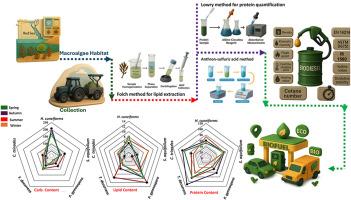利用多变量模型将季节性与红海褐藻生物柴油效率联系起来
IF 5.8
2区 生物学
Q1 AGRICULTURAL ENGINEERING
引用次数: 0
摘要
本研究评估了来自红海北部不同季节的五种褐藻,重点研究了它们作为生物柴油生产潜在候选物种的生理参数。采用多元统计分析方法评价海水理化参数对藻类生物活性成分的影响。研究结果表明,碳水化合物浓度在较冷的季节达到峰值,楔形草在秋季达到最大值206.76 mg/g。蛋白质浓度表现出物种特异性的稳定性,马尾藻保持相对恒定的水平,约为67 mg/g。裸孢子帕迪纳菌从冬季的46.47 mg/g显著减少到春季的20.37 mg/g。脂质含量呈现出明显的季节波动,其中裸子孢子P. gymnospora在夏季达到峰值9.78 mg/g。主要的脂肪酸是棕榈酸和硬脂酸,对生物柴油的稳定性至关重要。夏莪油十六烷值较高,达76.33;秋莪油冷流性较好,达3.31℃,适合生产优质生物柴油。这表明,对季节变化的多变量分析和理解可以改善红海褐藻的种植、收获和生物柴油生产的优化。本文章由计算机程序翻译,如有差异,请以英文原文为准。

Using multivariate models to link seasonality and biodiesel efficiency in red sea brown algae
This study evaluated five Phaeophyta species from the northern Red Sea during different seasons, focusing on their physiological parameters as potential candidates for biodiesel production. Multivariate statistical analysis was used to assess the effect of seawater's physicochemical parameters on the bioactive compounds of Phaeophyta. The findings demonstrated that carbohydrate concentrations peaked during cooler seasons, with Hormophysa cuneiformis exhibiting a maximum value of 206.76 mg/g in the fall. The protein concentration demonstrated species-specific stability, with Sargassum aquifolium maintaining relatively constant levels of approximately 67 mg/g. Padina gymnospora significantly diminished from 46.47 mg/g in winter to 20.37 mg/g in spring. The lipid content exhibited considerable seasonal fluctuations, with P. gymnospora attaining a peak of 9.78 mg/g during summer. The predominant fatty acids were palmitic and stearic, crucial for the stability of biodiesel. Turbinaria decurrens exhibited higher cetane numbers of 76.33 in summer and remarkable cold flow properties of 3.31 °C in fall, underscoring its suitability for high-quality biodiesel production. This indicates that multivariate analysis and comprehension of seasonal variation can improve the optimization of cultivation, harvesting, and biodiesel production from the brown macroalgae in the Red Sea.
求助全文
通过发布文献求助,成功后即可免费获取论文全文。
去求助
来源期刊

Biomass & Bioenergy
工程技术-能源与燃料
CiteScore
11.50
自引率
3.30%
发文量
258
审稿时长
60 days
期刊介绍:
Biomass & Bioenergy is an international journal publishing original research papers and short communications, review articles and case studies on biological resources, chemical and biological processes, and biomass products for new renewable sources of energy and materials.
The scope of the journal extends to the environmental, management and economic aspects of biomass and bioenergy.
Key areas covered by the journal:
• Biomass: sources, energy crop production processes, genetic improvements, composition. Please note that research on these biomass subjects must be linked directly to bioenergy generation.
• Biological Residues: residues/rests from agricultural production, forestry and plantations (palm, sugar etc), processing industries, and municipal sources (MSW). Papers on the use of biomass residues through innovative processes/technological novelty and/or consideration of feedstock/system sustainability (or unsustainability) are welcomed. However waste treatment processes and pollution control or mitigation which are only tangentially related to bioenergy are not in the scope of the journal, as they are more suited to publications in the environmental arena. Papers that describe conventional waste streams (ie well described in existing literature) that do not empirically address ''new'' added value from the process are not suitable for submission to the journal.
• Bioenergy Processes: fermentations, thermochemical conversions, liquid and gaseous fuels, and petrochemical substitutes
• Bioenergy Utilization: direct combustion, gasification, electricity production, chemical processes, and by-product remediation
• Biomass and the Environment: carbon cycle, the net energy efficiency of bioenergy systems, assessment of sustainability, and biodiversity issues.
 求助内容:
求助内容: 应助结果提醒方式:
应助结果提醒方式:


